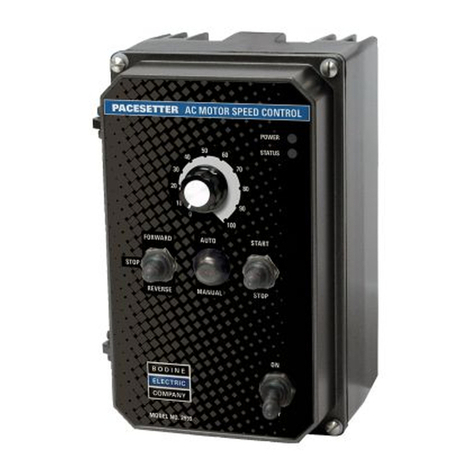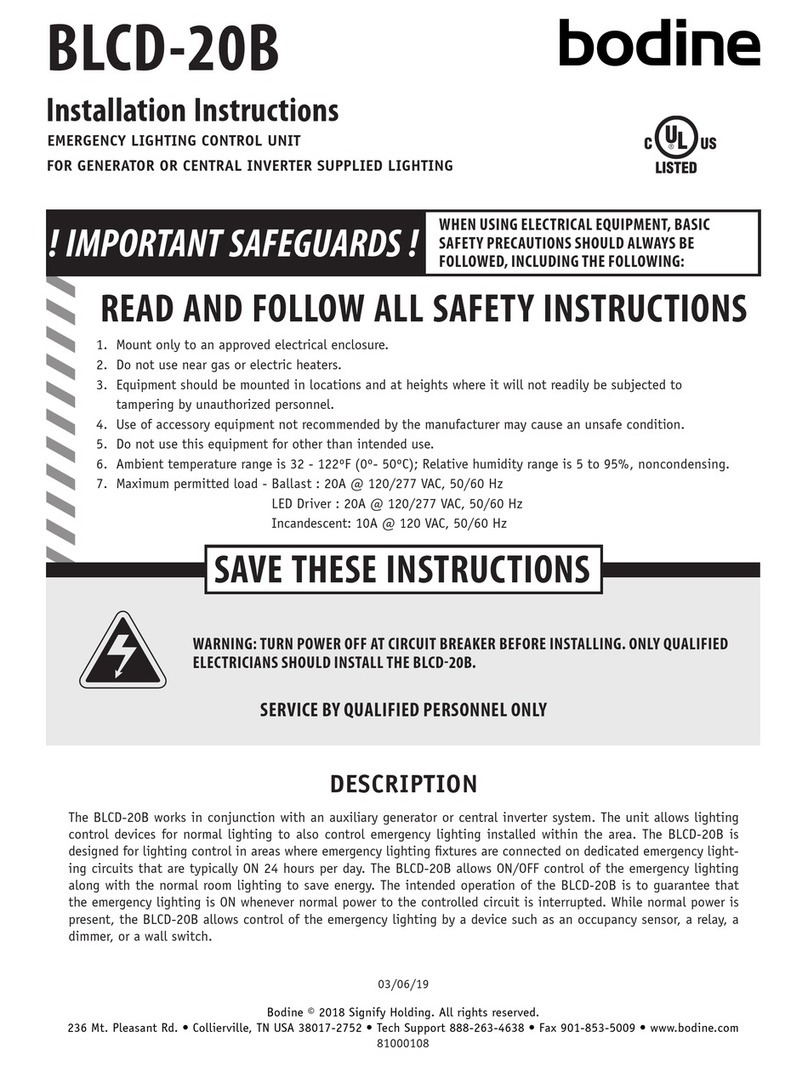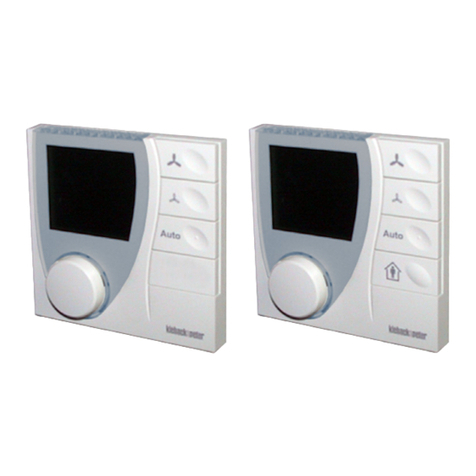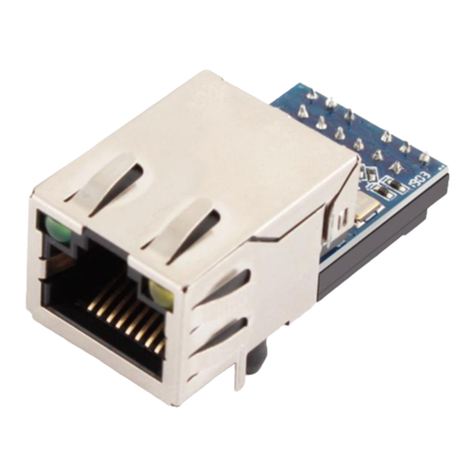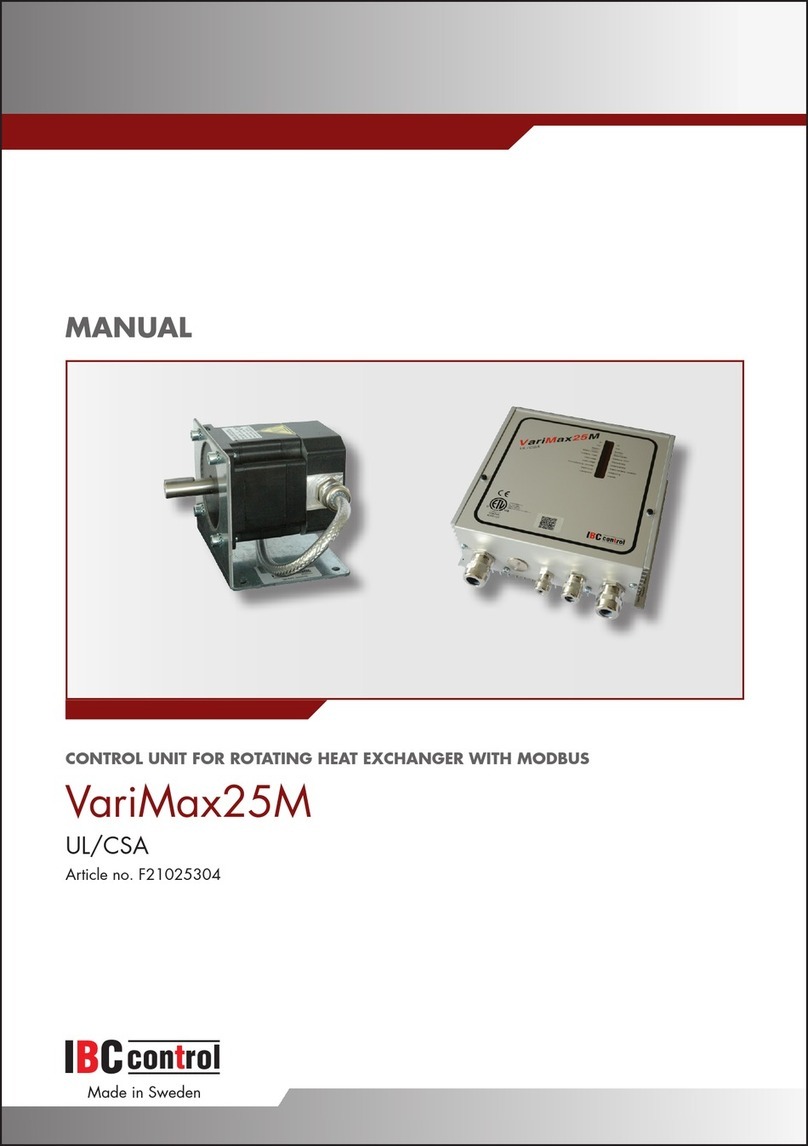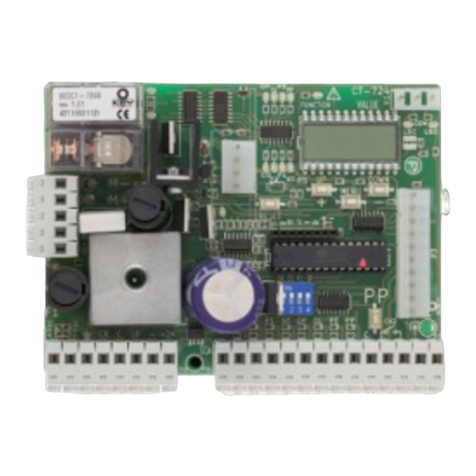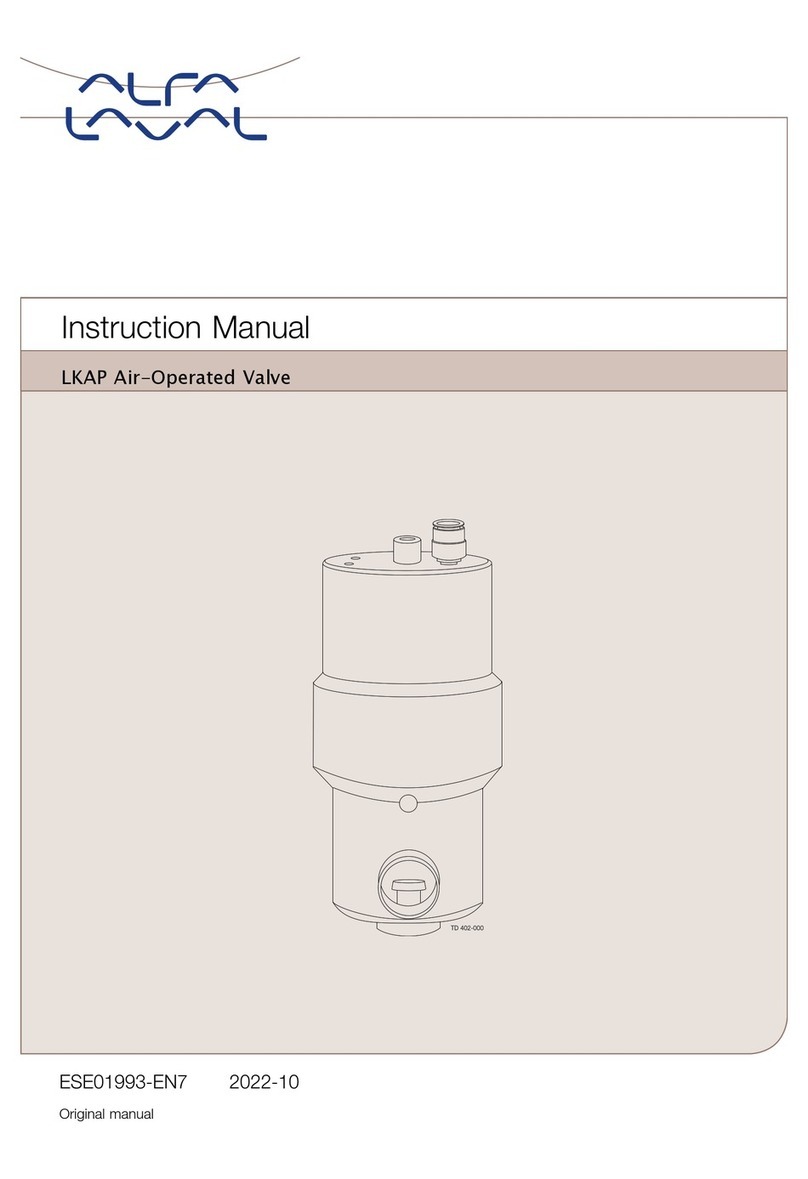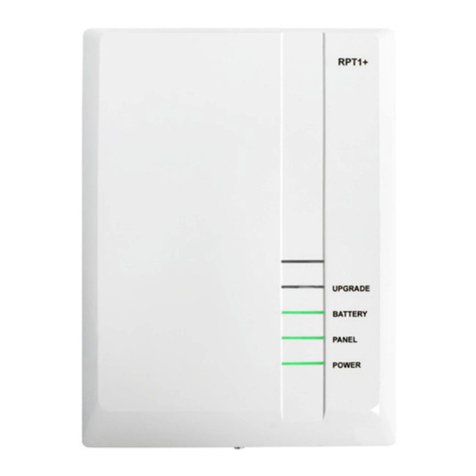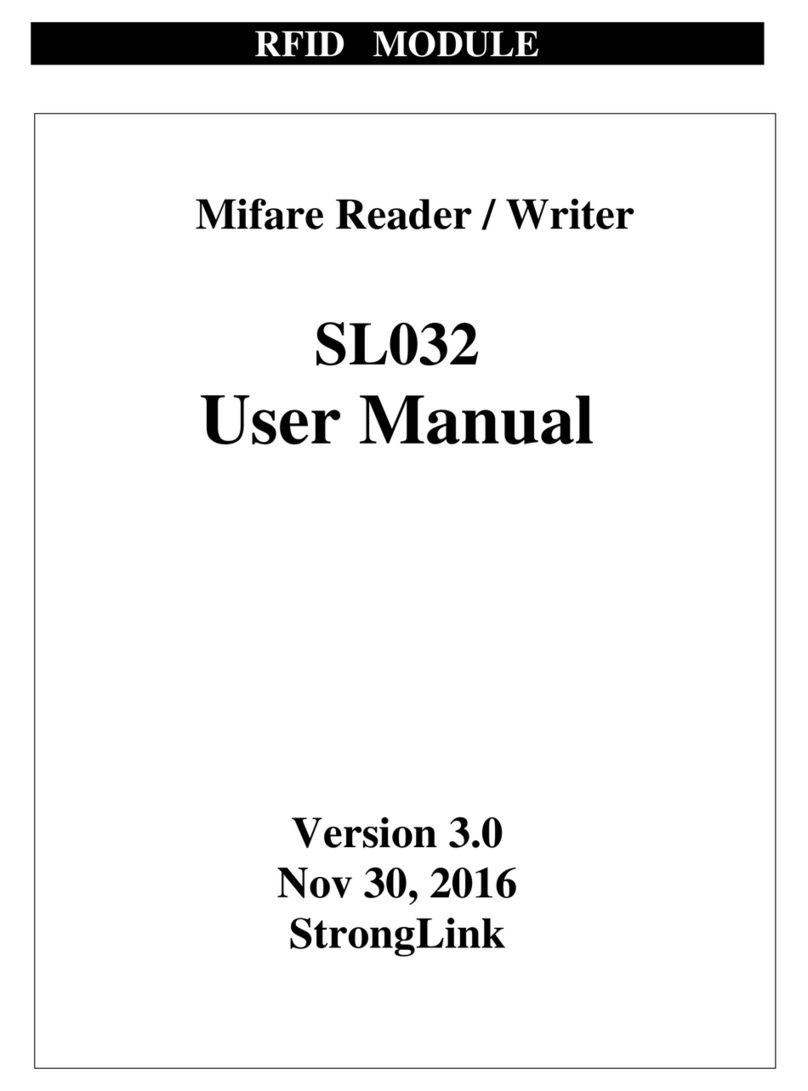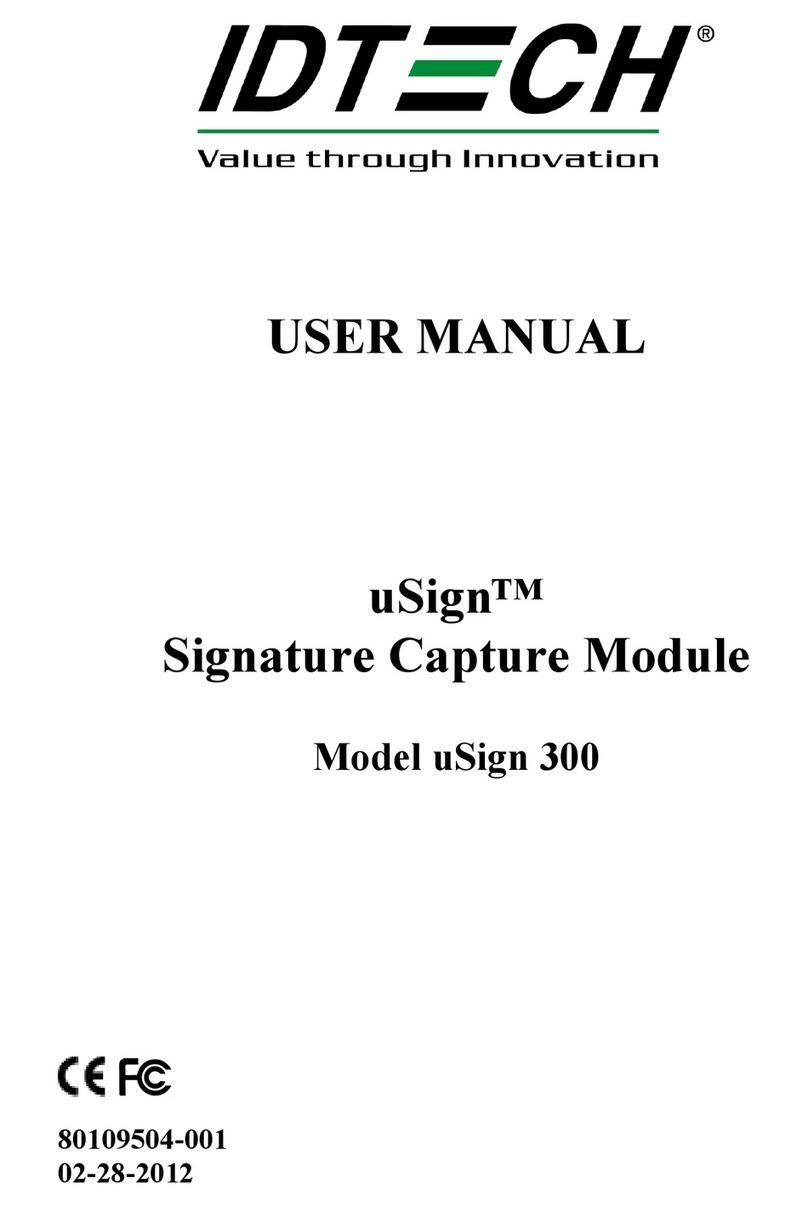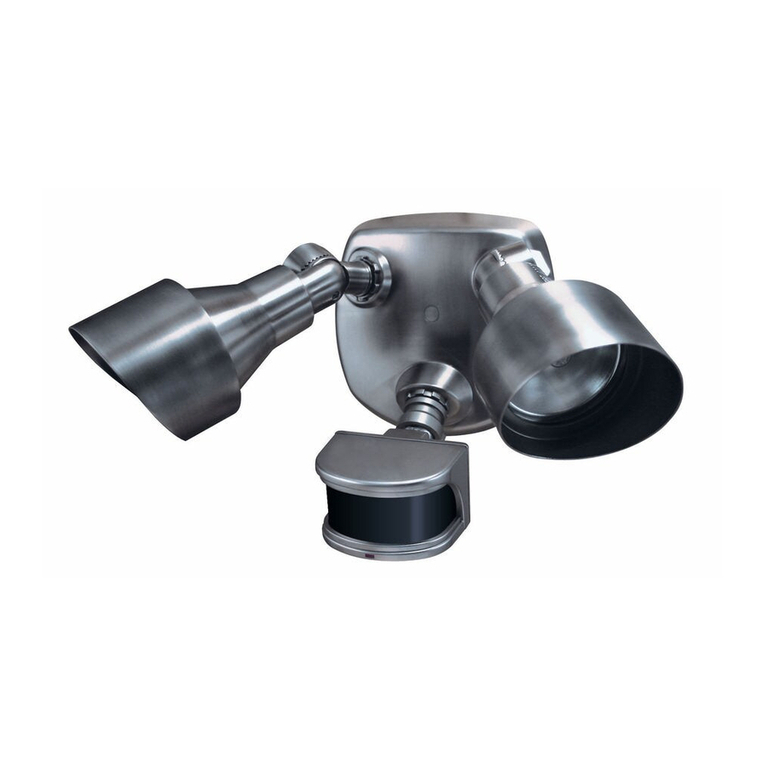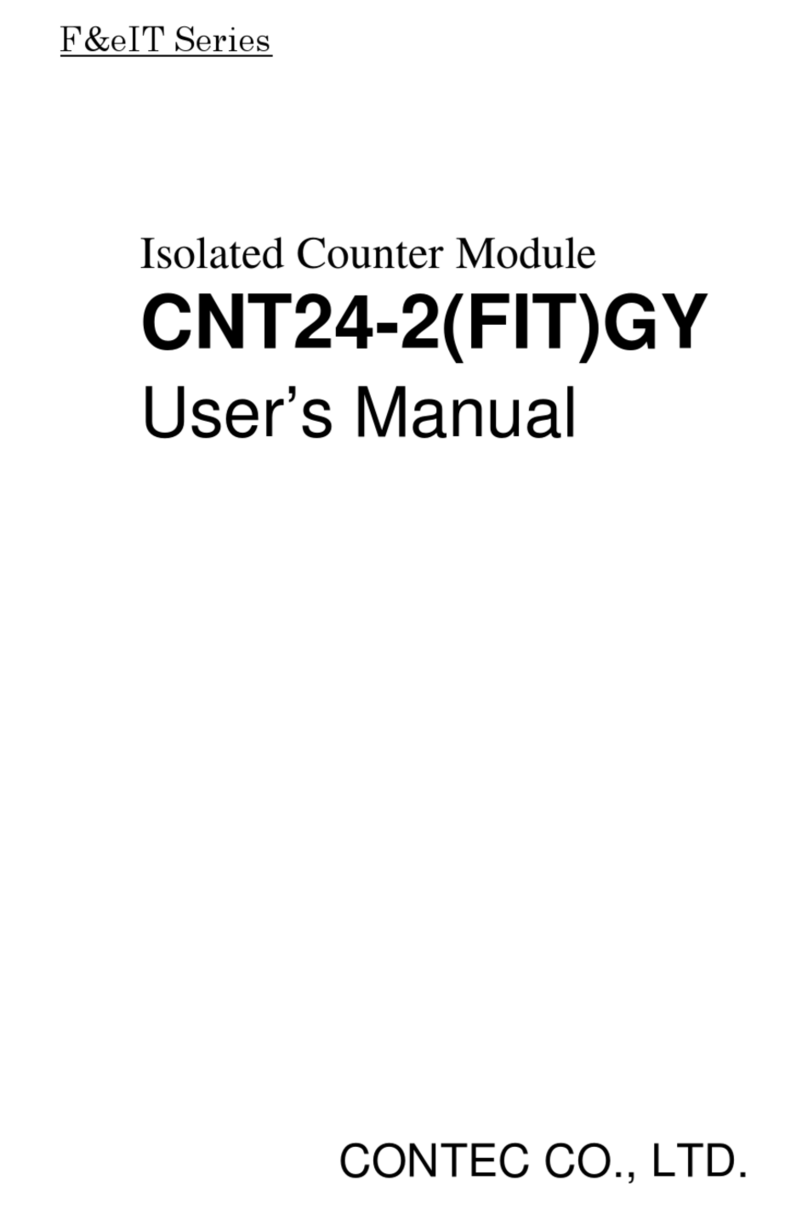Bodine ABL-3911C User guide

SPECIFICATIONS
Product Type ....................................ABL-3911C/ABL-3921C
Input Voltage.....................................115 VAC ± 10%, 50/60 Hz (Single Phase)
Input Current.....................................12 Amps rms maximum
Output Voltage ..................................0 to 130 VDC
Continuous Output Current.........................3.0 Amps
Peak Output Current ..............................6.0 Amps
Ambient Temperature .............................0 to 50° C
Motor HP Range: .................................Up to 3/8 HP
Speed Range: ...................................Up to 30:1
Speed Regulation: ...............................Less than 1% of rated (Typical)
Model 3911 0-2500 rpm
Model 3921, 0-10,000 rpm
Filtered SCR Brushless DC
Motor Speed Controls
Part No. 07400211.C
www.bodine-electric.com
Instructions for Installation and Operation

2www.bodine-electric.com
QUICK REFERENCE
IMPORTANT
Read this manual completely and carefully. Pay special attention to all
warnings, cautions, and safety rules. Failure to follow the instructions
could produce safety hazards which could injure personnel or damage
the control, motor, or other equipment. If you have any doubts about how
to connect the control or motor, refer to the detailed sections of
this manual.
Figure 1 – Quick Reference Diagram
Front View
S3 S2 S1
10K OHM SPEED POT
(included)
A
B
C
Shielded Commutation
Cable*
COM (
Black)
H– (
Black)
HC (
Green)
HB (White)
HA (Brown)
H+ (Red)
CONTROL INPUTS
(Page 13)
INTERNAL ADJUSTMENTS
(Page 19)
DIR
DIRCOM
DISABLE
DISCOM
DECEL
DECLCOM
Direction Switch
Closed=CW; Open=CCW
Disable Switch
Closed=brake to stop; Open=run
Decel Switch
Closed=decel. to stop; Open=run
Bodine
BLDC
Motor
Brown
Shield
Red
Orange
Green-Yellow
AC POWER INPUTS
(Page 17)
115 V
50/60 Hz
Earth
Ground
Chassis
Ground
Screw
Yellow
Orange
Blue
SPEED POT INPUTS
(Page 14)
S2
S3
S1
MAX: Adjust (or ”scale”) maximum
motor speed. CW increases speed.
MIN: Adjust motor minimum
speed. CW increases speed.
ACCEL: Adjust motor acceleration
response time. CW increases time.
DECEL: Adjust motor deceleration
response time. CW increases time.
TORQ: Adjust motor torque limit.
CW increases torque limit.
MOTOR
PHASE
OUTPUTS
(Page 13)
Neutral Line
COMMUTATION
SENSOR INPUTS
(Page 14)
* We offer an optional 6-foot cable kit, Model 3983

www.bodine-electric.com 3
© 2020 Bodine Electric Company.
All rights Reserved. All data subject to change without notice. Printed in U.S.A.
TABLE OF CONTENTS
QUICK REFERENCE INSTALLATION .......................................2
GENERAL INFORMATION ...............................................4
CONTROL DESCRIPTION AND FEATURES..................................5
SPECIFICATIONS .......................................................6
IMPORTANT SAFETY PRECAUTIONS......................................6
INSTALLATION INSTRUCTIONS ..........................................9
Mounting the Control ................................................9
Electrical Connections .................................................10
Cable Assembly ....................................................10
Horsepower (DIP) Switch Settings ....................................11
Motor Commutation Phasing (60° standard) ............................12
Commutation Sensor Connections ....................................12
Motor Phase Connections ...........................................13
Fuse Installation ....................................................13
Manual Control Input Connections ....................................13
Electronic Control Input Connections..................................15
Tachometer Output .................................................16
AC Power Connections ..............................................17
OPERATING INSTRUCTIONS ............................................18
Preliminary Checks .................................................18
Operating the Controls ..............................................18
Internal Adjustments ................................................19
Minimum and Maximum Speed........................................19
Torque (Current) Limiting Adjustment...................................19
Acceleration Adjustment .............................................20
Deceleration Adjustment .............................................20
TROUBLESHOOTING ...................................................21
WARRANTY...........................................................23
FIGURES
Figure 1 – Quick Reference Diagram ......................................2
Figure 2 – Heatsink Orientation ..........................................10
Figure 3 – Model 3983 Cable Assembly ...................................10
Figure 4 – Control Circuit Board Detail....................................11
Figure 5 – DIP Switch 7 and 8 Speed Range Settings .......................12
Figure 6 – Horsepower (DIP Switch) Settings and Fuse Selection Chart ......12
Figure 7 – Manual Speed Potentiometer/Interface Details ..................14
Figure 8 – Manual Switch and Relay Control Inputs ........................14
Figure 9 –Connection to Model 3984 Isolation Interface ....................16
Figure 10 – Tachometer Output ..........................................16
Figure 11 – Speed/Torque Curve Showing Reduced
Torque Limit at Low Speeds ....................................20

4www.bodine-electric.com
GENERAL INFORMATION
Congratulations!
And thank you for selecting the Bodine Type ABL Brushless DC Motor Control.
Your new control will provide the same excellent performance and reliability
that have been a Bodine tradition since 1905. Bodine Electric Company
takes pride in the quality of its products and in satisfying its customers.
Every effort has been made to provide you with a product free of defects in
design, workmanship, and materials. In order for us to maintain our tradition
of quality, please report any cases of unsatisfactory service or products to
Bodine Electric Company promptly.
About This Manual
This manual contains the basic information needed to install and operate
a Bodine Model ABL-3911C and ABL-3921C Control. It is organized in a
systematic, step-by-step fashion so that the system may be set up safely in
the shortest possible time. It does not profess to cover all details or variations
in equipment, nor to provide for every possible contingency associated
with installation, operation, or maintenance – and no warranty of fitness for
purpose is expressed or implied. Should further information be desired or
should particular problems arise which are not covered sufficiently for the
user’s purpose, the matter should be referred to the Bodine Electric Company.
The issuance of this manual does not confer to the recipient any license to
manufacture under any patents owned or controlled by the Bodine Electric
Company.
Safety Standards
Bodine products are designed and manufactured to comply to applicable
safety standards and in particular to those issued by ANSI (American National
Standards Institute), NEMA (National Electrical Manufacturers Association),
and UL.
Type ABL controls “recognized by UL Inc.” are designated by
having a UR symbol. In addition, products that are CSA certified,
are identified by a CSA symbol. If you need specific information
regarding the third party approval status of Bodine products,
contact the nearest Bodine representative, or the home office.

www.bodine-electric.com 5
CONTROL DESCRIPTION AND FEATURES
The ABL-3911C and ABL-3921C Brushless DC Motor Controls are chassis style
controls, designed to be mounted into a separate control enclosure supplied
by the user. They operate from a nominal 115 VAC, 50/60 Hz. power source
and provide electronic commutation and phase current switching needed
to operate brushless DC motors. DIP switch selectable current limit settings
allow the controls to be used with several fractional horsepower motors and
gearmotors. The controls are factory pre-set for 60° commutation.
The ABL-3911C and ABL-3921C provide a 130 Volt filtered output for improved
form factor, plus a built-in dynamic braking module. They allow motor speed
to be manually or electronically controlled.
Motor direction of rotation, braking or disabling, and soft starts and stops can
be controlled with manual switch inputs or by logic control. Since the control’s
signal common is not at ground potential, interface circuitry is required to
isolate logic signals from the control. Trim potentiometers on the control board
allow additional fine tuning of minimum and maximum speed settings, torque,
acceleration and deceleration time. A built-in “Smart ReverseTM” circuit
prevents plug reversing by braking the motor to a stop before changing its
direction. A built-in shutdown circuit disables the control during overvoltage,
under-voltage, or invalid commutation sensor state conditions.
Specific Bodine motor sizes which can be used with this control are listed in
the Chart in Figure 6.
Accessory Items
• Model 3983 Connection Cable Assembly — connects standard Bodine
brushless DC motors and gearmotors to ABL-3911C and ABL-3921C
controls. Length: 6 foot. (see page 10).
• Model 3982 Extension Cable — extends cable between motor and
control by six feet. Both ends equipped with circular connectors for easy
connection between Model 3983 Cable and motor. Length: 6 ft.
• Model 3984 Isolated Interface Module (See page 16.)

6www.bodine-electric.com
Parameter Specification
Product Type ABL-3911C/ABL-3921C
Input Voltage 115VAC±10%, 50/60 Hz
(Single Phase)
Input Current 12 Amps rms maximum
Output Voltage: 0 to 130 VDC
Continuous Output Current 3.0 Amps
Peak Ouput Current 6.0 Amps
Ambient Temperature: 0 to 50° C
Motor HP Range: Up to 3/8 Hp
Speed Range: Up to 30:1
Speed Regulation: Less than 1% of rated (Typical)
Line Voltage Compensation: Negligible speed change with changes in
line voltage
Acceleration Time Range: (Model 3911): 0.2 to 10 sec. (0 to full speed)
(Model 3921): 0.5 to 30 sec. (0 to full speed)
Dimensions: inches: 5.5 W x 8.0 D x 2.7 H
cm: 14.0 W x 20.4 D x 6.9 H
Net Weight 2.5 lbs. (1.12 kg.)
*MIN and MAX adjustments are limited to within the 0-10 VDC limits of VOUT
IMPORTANT SAFETY PRECAUTIONS
The following safety precautions must be observed during all phases of
installation, operation, service, and repair of this motor control product.
Failure to comply with these precautions or with specific warnings elsewhere
in this manual violates safety standards of design, manufacture and intended
use of the products. Bodine Electric Company assumes no liability for the
customer’s failure to comply with safety requirements and practices.
The use of electric motors and gearmotors, like that of all utilization of
concentrated power, is potentially hazardous. The degree of hazard can be
greatly reduced by proper design, selection, installation, and use, but all
hazards cannot be completely eliminated. The reduction of hazards is a joint
responsibility between the user, the manufacturer of the driven or driving
equipment and the manufacturer of the control or motor and interface circuitry.
The user should refer to Publication No. ANSI C5.1/NEMA MG 2, Safety
Standard for Construction and Guide for Selection, Installation and Use of
Electric Motors and Generators. Available from:
National Electrical Manufacturers Association
www.nema.org

www.bodine-electric.com 7
Warnings (such as the example below) highlight procedures which present
potential danger to people. Cautions highlight possible danger to equipment.
Both are used throughout this manual. Warnings and Cautions must always
be followed.
WARNING
Dangerous voltages may be present in the electronic control and motor.
These voltages could cause serious injury or death. Use extreme caution
during handling, testing, and adjusting. Properly guard the electronic
control and motor to prevent accidental contact by all persons.
The chance of explosions, fires, or electric shocks can be reduced
with thermal and over-current protection, proper grounding, enclosure
selection, and good maintenance. The following safety considerations
are not intended to be all-inclusive. Specific references throughout this
manual should also be consulted.
CAUTION
These controls are designed to provide optimum performance when
used with Bodine Electric Company motors. They should not be used with
other manufacturer’s motors without first contacting the Bodine Electric
Company. Failure to contact Bodine in advance could cause damage to
the control or the motor
Inspecting the Control
Check the items you received against your purchase order. Carefully examine
the control (and any optional kits or parts) for shipping damage. Parts errors
should be reported to Bodine. Shipping damage claims should be made to the
freight carrier.
Before installation, review the application to confirm that the proper motor and
control have been selected. This should be done after reading the documents
provided with the motor and all applicable safety standards. If in doubt, contact
your Bodine representative, or the home office if there is no representative
in your area. Although Bodine Electric Company assists its customers in
selecting motors and controls for specific applications, determination of
fitness for purpose or use is solely the customer’s responsibility.

8www.bodine-electric.com
Normal Operating Conditions
Unless otherwise agreed to by Bodine, all control nameplate ratings are
based on the following normal operating conditions. Consult Bodine Electric
Company if variations beyond these limits are anticipated.
1. Continuous Duty: without frequent reversals or starts and stops.
2. Maximum Ambient Temperature: 50° C (122° F) for chassis controls; 40° C
(104° F) for all encased controls.
3. Voltage: Within 10% of nameplate rating.
4. Frequency: Within 5% of nameplate rating.
5. Combined Variation of Voltage and Frequency: Within a total of 10%
providing frequency variation does not exceed 5%.
Grounding
Both electronic controls and motors must be securely mounted and adequately
grounded. Failure to ground properly may cause serious injury to personnel.
Fusing
Both the control input and output are fused. When fuses are replaced, they
must always conform to the values and ratings specified on the control’s
nameplate or in the fuse chart located in Figure 6.
Live Circuitry
Open-type electronics should be properly guarded or enclosed to prevent
accidental human contact with live circuitry. No work should be performed on
or close to the control or motor while the control is connected to the AC line.
If an AC line switch is used, it should be a Double Pole Single Throw (DPST),
so that both sides of the AC line are disconnected.
Environment
Open circuit boards in ventilated enclosures may emit flame during failure.
Bodine does not offer an explosion-proof line of motion control accessories for
hazardous locations (e.g., environments of flammable or explosive gas, vapor,
or dust). Bodine recommends using only approved explosion-proof products
in hazardous locations. The National Electric Code (NEC) allows exceptions,
but NEC and NEMA safety standards should be studied thoroughly before
exercising this option.
Moisture increases the electrical shock hazard of electrical insulation.
Therefore, open-type or unsealed controls not specifically designed for such
use should be protected from contact with liquids or moisture.
Ventilated Products
Open, ventilated products are suitable for clean, dry locations where cooling
air is not restricted. Do not insert anything into a product’s ventilation openings.

www.bodine-electric.com 9
Servicing
Emergency field repairs must be made only by authorized Bodine service
representatives. Repairs made by persons not authorized by the Bodine
Electric Company will void the warranty. Field repairs must be limited to
replacing an entire printed circuit board assembly. Because of the danger of
introducing safety hazards, do not install substitute parts or perform any
unauthorized modifications to electronic PC boards, components or motors.
To ensure continued compliance with the design specifications and safety
standards, the electronic control or motor should be returned to Bodine
Electric Company or an Authorized Service Center for servicing.
WARNING
To avoid injury because of unsuspected mechanical motion, always
disconnect the power supply to the motor control before performing any
service procedures on the motor, control, interface circuitry or driven
equipment.
WARNING
This control should only be installed by a qualified technician, electrician or
electrical maintenance person familiar with its operation and associated
hazards. The National Electrical Code (NEC), local electrical and safety
codes, and when applicable, the Occupational Safety and Health Act
(OSHA) should be observed to reduce hazards to personnel and property.
The user must provide a proper enclosure for chassis type controls.
Circuitry is not at ground potential. Do not perform work on or near the
control while it is connected to the AC line.
CAUTION
Only copper wire with a minimum 60° C rated insulation is recommended
if Bodine cable assemblies are not used. The control terminal block will
accept leads up to 14 gauge (18 gauge is the smallest recommended size).
Mounting the Control
Detailed mounting dimensions and CAD drawings are available online. The
control should be mounted vertically so that the control panel is readable
and the cabling extends from the bottom of the enclosure. This arrangement
provides optimum air flow around the control.
The control does not provide motor over temperature protection. The user is responsi-
ble for providing this protection in the equipment where this control is used (Remarque:
La détection de la surchauffe du moteur n’est pas assurée par cette control).
INSTALLATION INSTRUCTIONS

10 www.bodine-electric.com
Electrical Connections
Read the following instructions as well as all of the applicable safety
recommendations, before making any electrical connections between the
control, motor, or motion control electronics.
WARNING
The 115 VAC power line to the control should be the very last connection
made. Disconnect the power line before making any other electrical
connections.
Figure 2– Heatsink preferred mounting orientation
.25
R.100 SLOTS
[4 PLACES]
3.00
TYP.
1.25
TYP.
7.50 7.50
8.00
.63
TYP.
.25
R.100 SLOTS
[2 PLACES]
(3.87)
(3.02)
Figure 3 - Model 3983 Cable Assembly
11
Cable Assembly: The Model 3983 Cable Assembly, shown in Figure 3, is
designed to simplify the electrical connections to the ABL-3911C and
ABL-3921C Controls. One end of the cable which connects to the motor is
terminated with a circular type connector. The other end which connects to the
control has a six-pin rectangular connector, three individual motor phase leads
with quick disconnects, and an earth ground lead.
Figure 2 - Heatsink orientation
Figure 3 - Model 3983 Cable Assembly
Earth Ground Lead
To Control
Motor
Phase
Leads
Commutation Sensor Connector
To Motor
Mates to Motor Connector
or Model 3982 Extension Cable
Cable Assembly
The Model 3983 Cable Assembly, shown in Figure 3, is designed to simplify
the electrical connections to the ABL-3911C and ABL-3921C Controls. One
end of the cable which connects to the motor is terminated with a circular
type connector. The other end which connects to the control has a six-
pin rectangular connector, three individual motor phase leads with quick
disconnects, and an earth ground lead.

www.bodine-electric.com 11
Q12 Q10 Q13 Q11
VR1
MM-
L N A CB
T2
MOTOR FUSE
LINE FUSE
S1 S2 S3 T-OUT T-COM
SPEED POT
DIR
DIRCOM
DISABLE
DISCOM
DECEL
DECELCOM
FAULT
POWER
COM
H-
HC
HB
HA
H+
CONTROL INPUTS
COMMUTATION
SENSOR INPUTS
TORQ: (CW increases torque limit.)
DECEL: (CW increases time)
ACCEL: (CW increases time)
MIN: (CW increases speed)
MAX: (CW increases speed)
RED FAULT LIGHT
(Indicates a problem with
the commutation sensor connection)
GREEN POWER LIGHT
(Indicates AC power
is applied)
TERMINAL BLOCK
HORSEPOWER
SELECT SWITCHES
MAX MIN ACCELDECEL TORQ
Figure 4 - Control Circuit Board Detail
Horsepower (DIP Switch) Settings
Figure 4 shows a Horsepower Select switch on the main control board which
contains eight switch levers numbered 1 through 8. The chart in Figure 6
shows the proper DIP switch settings for various Bodine motor types.
Determine the first four digits of the motor’s type number from the nameplate.
Find the same four digits in the chart in Figure 6 to determine the proper
settings of the DIP switches. An insulated alignment tool should be used to
adjust the switch settings.
WARNING
The shield common is at a dangerous potential above ground and presents a
voltage hazard. Contact with the shield could cause serious injury or death.
If a non-Bodine cable is used or if a special cable is fabricated, care should
be taken to insulate all exposed shield to avoid serious injury. The shield
should only be connected to COM terminal on the Commutation Sensor
Input Connector at the control. No other shield connection should be made.
CAUTION
Only copper wire with a minimum 60° C rated insulation is recommended if
Bodine cable assemblies are not used. The control terminal block will
accept leads up to 14 gauge (18 gauge is the smallest recommended size)

12 www.bodine-electric.com
Motor Commutation Phasing (60° standard)
All standard (stock) brushless DC motors and gearmotors manufactured by
Bodine Electric Company are designed for 60° commutation. The factory
setting for our BLDC speed controls is also for 60° commutation. It is possible
to configure our BLDC stock controls to operate non-Bodine BLDC motors
and gearmotors with 120° commutation angle. To change the sensor phasing
output on our stock controls for 120° commutated gearmotors or motors, set
DIP switch number 6 to the “Off” position. Please note that further application
details must be considered to properly match a non-Bodine BLDC motor with
one of our stock BLDC controls. To avoid damage or system performance
issues, please consult our Technical Support staff at 773-478-3515 or via
E-mail: [email protected].
Control Bodine Motor or Rated DIP Switch Line Motor AC rms Input
Model No. Gearmotor Type Hp Speed (RPM) “On” Position Fuse (F1) Fuse (F2) Current
22B2…1/162,6,8MDA 6/102.7
22B3… 1/11 1,2,6,8MDA 8/10 3.6
ABL-3911C22B4…1/82,5001,3,6,8ABC 15 MDA 1-1/4 4.8
34B3…1/51,2,3,6,8MDA 1-1/26.7
34B4…1/42,4,6,8MDA 2 8.0
34B6…3/81,5,6,8MDA 3 11.1
ABL-3921C22B4…1/510,000 1, 2, 3,6,8ABC 15 MDA 1-1/2 6.7
34B4… 1/3 1, 3, 4,6,8MDA 2-1/2 9.5
Figure 6 – Horsepower (DIP Switch) Settings and Fuse Selection Chart
Typical MAX Motor Speeds with 10 K Speed Pot
DIP Switch
7
DIP Switch
8
CCW MAX
Pot
Calibrated
MAX Pot
CW MAX
Pot1
T-Out Pulse
Width (µS)
ON ON 1000 1700 2000 1200
ON OFF 1000 1700 2000 1200
Factory Setting OFF ON 1500 2500 3000 800
OFF OFF 1500 2500 3000 800
1. Max. Speed obtainable is dependent on motor winding (voltage, speed rating, resistance),
line voltage and load conditions.
Figure 5 – DIP Switch 7 and 8 Speed Range Settings
Commutation Sensor Connections
The commutation sensor leads are prewired in the Model 3983 cable assembly
and terminated in a six-pin connector (Figure 3). There is a corresponding
“Commutation” connector on the main control board (Figure 4). Mate the
polarized cable connector to the “Commutation” connector. The connectors
can only mate one way.

www.bodine-electric.com 13
Motor Phase Connections
Locate the barrier terminal block mounted to the bracket above the main
control board. Refer to Figure 4:
1. Cut the quick connect terminals from the brown, red, and orange motor
phase leads.
2. Strip away approximately 1/4 inch of the insulation from the leads.
3. Connect the stripped leads to the barrier terminal block as follows:
• Brown to Terminal “A BRN”
• Red to Terminal “B RED”;
• Orange to Terminal “C ORG”
Fuse Installation
The control input and output are fused. The line input fuse has been installed
at the factory. The control output or “Motor Fuse” must be selected based on
the size of the motor.
Line Fuse
The location of line fuse (F1) is shown in Figure 4. It should always be replaced
with a fuse of the same type and rating. Its rating can be determined by
referring to the chart in Figure 6.
Motor Fuse
The location of motor fuse (F2) is shown in Figure 4. The fuse rating will vary
with the size of the motor used. To determine the proper fuse rating, locate
the first four digits of your motor’s type number on the motor nameplate. Find
the same four digits in the chart in Figure 6 to determine the fuse size. The
ABL-3911C and ABL-3921C are supplied with the fuses listed in Figure 6.
Manual Control Input Connections
Motor speed, braking, direction of rotation and deceleration can be controlled
manually or electronically. Refer to the following procedures for connecting
control inputs.
CAUTION
The control board signal common is not at ground potential. Any external
signal or equipment connected to the control must be electrically isolated from
ground (e.g., with relay contacts or optical isolation module). Non-isolated
signals will damage the control and/or associated external equipment.

14 www.bodine-electric.com
Manual Speed Control
A Manual Speed Potentiometer Kit for
controlling motor speed is supplied
with the Model ABL- 3911C and ABL-
3921C. The kit contains a 10K Ohm
potentiometer, mounting hardware, and
three 24-inch long leads terminated on
one end with 1/4 inch quick connects.
To connect the speed potentiometer,
proceed as follows:
1. Solder the three leads to the
potentiometer as shown in Figure 1.
2. Mount the potentiometer in the
desired location.
3. Connect the speed pot to the control board terminals as follows:
• Blue to Terminal “S1”
• Orange to Terminal “S2”
• Yellow to Terminal “S3”
Manual Braking (Disable), Direction
of Rotation, and Deceleration
Mechanical switches or relays
can be used to switch the control
inputs. Figure 8 shows a schematic
representation of manual or relay
switched inputs.
NOTE: Shielded cable is recommended for the these
connections.
The following chart lists the control functions relative to the state of the
mechanical switches or relays.
Switch Closed Open
DISABLE1Stop Run
DIR2CW4CCW4
DECEL3Decelerate Accelerate
1. Dynamic braking will occur when the DISABLE switch is closed.
2. A”Smart Reverse Circuit” prevents plug reversing when the DIRection switch is
opened or closed. The motor brakes to a stop before changing direction.
3. The DECEL switch controls soft stops. The degree of deceleration can be varied
with the trim potentiometers on the control board. See Page 20.
4. The output shafts of gearmotors with odd number of stages (Bodine type
designations ending with WX, E1, or E3) will rotate in the opposite direction.
15
3. Connect the speed pot to the control board terminals as follows:
• Blue to Terminal "S1"
• Orange to Terminal "S2"
• Yellow to Terminal "S3"
Manual Braking (Disable), Direction
of Rotation, and Deceleration:
Mechanical switches or relays can be
used to switch the control inputs.
Figure 7 shows a schematic representa-
tion of manual or relay switched
inputs.
NOTE: Shielded cable is recommended
for the these connections.
The following chart lists the control
functions relative to the state of the
mechanical switches or relays.
Switch Closed Open
DISABLE1Fast Stop Run
DIR2CW4CCW4
DECEL3Slow Stop Run
1. Dynamic braking will occur when the DISABLE switch is closed
2. A"Smart Reverse Circuit" prevents plug reversing when the DIRection switch is opened or
closed. The motor brakes to a stop before changing direction.
3. The DECEL switch controls soft stops. The degree of deceleration can be varied with the trim
potentiometers on the control board. See Page 21.
4. The output shafts of gearmotors with odd number of stages (Bodine type designations ending
with W3, E1, or E3) will rotate in the opposite direction.
Figure 7 - Manual Switch and
Relay Control Inputs.
Manual
Switches
or Relay
Contacts
12V
10K 4000 Series
CMOS
12V
10K
12V
10K
4000 Series
CMOS
4000 Series
CMOS
DISABLE
DISCOM
DIR
DIRCOM
DECEL
DECLCOM
Signal Common
Figure 8 – Manual Switch and
Relay Control Inputs.
14
Fuse Installation: The control input and output are fused. The line input fuse
has been installed at the factory. The control output or "Motor Fuse" must be
selected based on the size of the motor.
Line Fuse: The location of line fuse (F1) is shown in Figure 4. It should
always be replaced with a fuse of the same type and rating. Its rating can be
determined by referring to the chart in Figure 5.
Motor Fuse: The location of motor fuse (F2) is shown in Figure 4. The fuse rating
will vary with the size of the motor used. To determine the proper fuse rating,
locate the first four digits of your motor's type number on the motor nameplate.
Find the same four digits in the chart in Figure 5 to determine the fuse size. The
ABL-3911C and ABL-3921C are supplied with the fuses listed in Figure 5.
Manual Control Input Connections: Motor speed, braking, direction of
rotation and deceleration can be controlled manually or electronically. Refer to
the following procedures for connecting control inputs.
CAUTION
The control board signal common is not at ground potential. Any
external signal or equipment connected to the control must be
electrically isolated from ground (e.g., with relay contacts or
optical isolation module). Non-isolated signals will damage the
control and/or associated external equipment.
Manual Speed Control: A Manual Speed
Potentiometer Kit for controlling motor
speed is supplied with the Model ABL-
3911C and ABL-3921C. The kit contains
a 10K Ohm potentiometer, mounting
hardware, and three 24-inch long leads
terminated on one end with 1/4 inch quick
connects. To connect the speed potenti-
ometer, proceed as follows:
1. Solder the three leads to the potenti-
ometer as shown in Figure 1.
2. Mount the potentiometer in the
desired location.
12V
10K
10K
100K
10K
100K
S3
S2
S1
51.1K
Signal Common
Signal Common
Maximum
Speed
Adjustment
Minimum
Speed
Adjustment
10K
–
+
Figure 6 - Manual Speed
Potentiometer/Interface details.
Figure 7 - Manual Speed
Potentiometer/Interface details.

www.bodine-electric.com 15
Electronic Control Input Connections
Optional Interface Boards are available from Bodine and other manufacturers.
They provide electrical isolation between the input signal and the brushless
DC motor control circuitry, and are recommended for motion control
applications requiring electronic control of motor speed, rotational direction,
deceleration, and braking.
Electronic Speed Control
Motor speed can be controlled with a 0 to +10 VDC isolated signal with 0.1 mA
current capability in lieu of the manual speed potentiometer. This speed
control input should be connected to terminal S2 on the control board. The
common side of the signal must also be isolated and connected to terminal
S1 on the main control board.
Logic Signal Control of Braking, Direction of Rotation, and Deceleration
Motor braking (or disable), direction of rotation and deceleration can be
controlled using optically isolated logic signals from a programmable
controller, personal computer, or other electronics.
WARNING
Never rely on logic circuitry as a means of disabling the motor or control.
To prevent unsuspected mechanical motion and potential injury, the 115
VAC power should always be disconnected whenever logic circuits or the
driven equipment are serviced.
Exercise extreme caution when using Programmable Logic Controllers
(PLCs). Although some may claim to have optically isolated output modules,
their output commons may be connected to other circuitry either within or
connected to the PLC. In such cases, the PLC outputs should be isolated from
the control board, by a relay or by an electronic isolation module, to prevent
damage to the PLC or the ABL Control.
If a Programmable Controller with a relay output module is not available, AC
or DC outputs from the PLC can be used to drive separate relay coils. See PLC
user’s manual for application information. See Figure 8 to determine how to
connect relay contacts to the ABL-3911C and ABL-3921C.

16 www.bodine-electric.com
Signal Isolation Using a Bodine Model 3984 Interface Module
Follow the installation instructions provided with the module to isolate the
input signals between the control electronics and the ABL Control. See Figure
9 for connections.
Figure 10 – Tachometer output
17
ISO +
Analog IN
T-OUT
DISABLE
DIR
S2
S1
ISO-
ICOM
VIN1
VIN2
IDIR
IDIS
ITAK
TB2
TAK
DIS
DIR
VOUT
COM
V+
Model 3984
ABL 3911/3921
Brushless DC Motor Control
Motor
Figure 8 - Connection to Model 3984 Isolation Interface
Signal Isolation Using a Bodine Model 3984 Interface Module: Follow the
installation instructions provided with the module to isolate theinput signals
between the control electronics and the ABL Control. See Figure8 for
connections.
Tachometer Output: When used with the Bodine ABL-3911/3921 Brushless
DC Motor Controls, the Model 3984 module provides a digital tachometer
output at the ITAK terminal for monitoring motor speed. The output pulse
levels are low tohigh to low. The typical pulse width is 0.8 msec. for the
ABL-3911 and 0.19 msec. for the ABL-3921. Twelve pulses correspond toone
motor revolution. The ITAK output provides an unterminated open collector
output. A pull-up resistor or another logic device is required for measuring the
output. See Figure 9 for assistance in interfacing the ITAK output.
User Logic Supply
V less than or
equal to 55V
l less than or
equal to
2 mA
User Input
(+)
User Equipment
Model 3984
Model 3984
Logic
Unterminated
Open Collector
Output
ITAK
ICOM
User-
Supplied
Pull-Up
Resistor
Figure 9 - Tachometer output
Pull-Up Resistor Values for
Common Logic Supplies
+VDC R (Ohms)
+5V4.7K
+12V10K
+24V15K
Tachometer Output
When used with the Bodine ABL-3911/3921 Brushless DC Motor Controls, the
Model 3984 module provides a digital tachometer output at the ITAK terminal
for monitoring motor speed. The output pulse levels are low to high to low.
The typical pulse width is 0.8 msec. for the ABL-3911 and 0.19 msec. for the
ABL-3921. Twelve pulses correspond to one motor revolution. The ITAK output
provides an unterminated open collector output. A pull-up resistor or another
logic device is required for measuring the output. See Figure 10 for assistance
in interfacing the ITAK output.
17
ISO +
Analog IN
T-OUT
DISABLE
DIR
S2
S1
ISO-
ICOM
VIN1
VIN2
IDIR
IDIS
ITAK
TB2
TAK
DIS
DIR
VOUT
COM
V+
Model 3984
ABL 3911/3921
Brushless DC Motor Control
Motor
Figure 8 - Connection to Model 3984 Isolation Interface
Signal Isolation Using a Bodine Model 3984 Interface Module: Follow the
installation instructions provided with the module to isolate theinput signals
between the control electronics and the ABL Control. See Figure8 for
connections.
Tachometer Output: When used with the Bodine ABL-3911/3921 Brushless
DC Motor Controls, the Model 3984 module provides a digital tachometer
output at the ITAK terminal for monitoring motor speed. The output pulse
levels are low tohigh to low. The typical pulse width is 0.8 msec. for the
ABL-3911 and 0.19 msec. for the ABL-3921. Twelve pulses correspond toone
motor revolution. The ITAK output provides an unterminated open collector
output. A pull-up resistor or another logic device is required for measuring the
output. See Figure 9 for assistance in interfacing the ITAK output.
User Logic Supply
V less than or
equal to 55V
l less than or
equal to
2 mA
User Input
(+)
User Equipment
Model 3984
Model 3984
Logic
Unterminated
Open Collector
Output
ITAK
ICOM
User-
Supplied
Pull-Up
Resistor
Figure 9 - Tachometer output
Pull-Up Resistor Values for
Common Logic Supplies
+VDC R (Ohms)
+5V4.7K
+12V10K
+24V15K
Figure 9 - Connection to Model 3984 Isolation Interface

www.bodine-electric.com 17
AC Power Connections
Power should always be the last connection made during installation and the
first item to be disconnected before servicing.
Power Input
WARNING
The control and motor must be securely and adequately connected to
earth ground as indicated below. Failure to ground properly may result in
serious injury.
Refer to Figure 4. Locate the barrier terminal block mounted to the bracket
above the main control board and connect AC power to the barrier terminal
block as follows:
1. Hot side of 115 VAC line to Terminal “L”.
2. Neutral side of 115 VAC line to Terminal “N”.
3. Cut the ring terminal off the Ground (Green/Yellow) wire of the 3983 cable.
Strip the insulation 1/4” and connect the wire to the terminal labeled with
the chassis ground symbol. This terminal should also be used to connect
the system to earth ground.

18 www.bodine-electric.com
OPERATING INSTRUCTIONS
Preliminary Checks
1. Before starting the control, check all fuses, connections, and adjustments
such as horsepower DIP switch settings.
2. Proper consideration should be given to all rotating members. Before starting,
be sure keys, pulleys, etc. are securely fastened. Proper guards should be
provided to prevent hazards to personnel while the equipment is rotating.
3. Mechanical considerations such as proper mounting and alignment of
products, and safe loads on shafts and gears should be reviewed. Do not
depend upon gear friction to hold loads.
4. The motor or gearmotor should be securely mounted (because of possible
reaction torque). Test the motor/gearmotor unloaded to be certain that
proper connections have been made.
Operating the Control
WARNING
Explosions, fires, or electric shock hazards can be reduced through thermal
and over-current protection, good maintenance, proper grounding, and
enclosure selection. Review safety considerations outlined in “Safety
Precautions” and “Installing the Control.”
WARNING
The 115 VAC line to the driver should be switched off before starting.
1. Turn input power OFF and set the speed potentiometer to ZERO (fully
counterclockwise). If a Disable switch is used, close the switch. If a
Direction switch is used set it for the desired direction of rotation. If a
Deceleration switch is used, open the switch. See Chart in Installation
Instructions, Manual Control Input Connections.
2. Connect the 115 VAC power line to the external power source. Then turn on
the 115 VAC input power to the control.
3. Open the Disable switch, if used.
4. Turn speed potentiometer knob until motor rotates. Then adjust the
potentiometer to achieve the desired speed. If you wish to reduce the
torque level, refer to Internal Adjustments below.
5. If the motor does not operate, first observe if the green POWER light and
red FAULT light are on (refer to Figure 4 for location). Then disconnect the
AC power to the control and check all connections and fuses. If a fuse is
blown and the motor is not locked (stalled) or overloaded, do not replace
the fuse. The control may be damaged. Refer to Troubleshooting on page
21 and follow instructions. If the motor is overloaded, reduce the load and
replace blown fuses with those of the proper type and rating as specified
in Figure 6.

www.bodine-electric.com 19
Internal Adjustments/Calibration
This control was shipped with the following factory settings:
Minimum speed: 0 RPM
Maximum speed: (ABL-3911C): 2,500 RPM; (ABL-3921C): 10,000 RPM
Acceleration: (ABL-3911C): 2 seconds; (ABL-3921C): 5 seconds
Deceleration: (ABL-3911C): 2 seconds; (ABL-3921C): 5 seconds
Torque: 200% of rated (based on proper DIP switch settings)
Commutation: 60°
Refer to Figure 4 for the trim potentiometer locations and approximate initial
settings. If you need to readjust the control for your specific applications,
proceed as follows:
Minimum and Maximum Speed
The MIN and MAX trim potentiometers have been factory calibrated. The
lowest MIN trim potentiometer setting (fully counterclockwise) corresponds
to 0 RPM and the highest MIN setting (fully clockwise) corresponds to
approximately 30% of rated speed.
The lowest MAX trim potentiometer setting (fully counterclockwise)
corresponds to 60% of rated speed and the highest MAX trim potentiometer
setting (fully clockwise) corresponds to approximately 120% of rated speed.
Refer to Figure 4 for trim potentiometer location and settings. Adjustment of
the MIN and MAX trim potentiometers may have to be repeated several times
to arrive at the desired speeds.
NOTE: Increasing the MIN potentiometer setting will increase the maximum speed
beyond nameplate speed. The MAX trim potentiometer will need to be readjusted.
Torque (Current) Limiting Adjustment
The TORQ trim potentiometer (Figure 4) has been calibrated to limit current to
200 to 250% of the motor’s rated current, assuming the DIP switches are set
properly. The motor’s torque output can be reduced to zero or stall torque.
Turn the TORQ trim potentiometer counterclockwise to decrease the torque
and clockwise to increase the torque.
WARNING
Use a nonmetallic or insulated adjustment tool (such as a television
alignment tool) for internal adjustments. Circuit components are not at
ground potential and accidental short circuiting and shock hazard may
occur with conducting tools. Adjustment should be made only by qualified
service personnel.

20 www.bodine-electric.com
Acceleration Adjustment
Adjusting the ACCEL trim potentiometer (See Figure 4) counterclockwise
decreases the motor’s acceleration time down to a minimum of approximately
0.2 seconds (ABL-3911C) or 0.5 seconds (ABL-3921C). A clockwise adjustment
increases the rate up to a maximum of approximately 10 seconds (ABL-3911C)
or 30 seconds (ABL-3921C).
Deceleration Adjustment
Adjusting the DECEL trim potentiometer (See Figure 4) counterclockwise
decreases the motor’s deceleration time down to a minimum of approximately
0.2 seconds (ABL-3911C) or 0.5 seconds (ABL-3921C). A clockwise adjustment
increases the rate up to a maximum of approximately 10 seconds (ABL-3911C)
or 30 seconds (ABL-3921C).
Stall 40
(Model
3921)
10,000
Speed (RPM)
0
020
Torque (oz. -in.)
100% 20 oz.-in.
Figure 11 – Speed/Torque Curve showing decreased torque limit at lower speeds
This manual suits for next models
3
Table of contents
Other Bodine Control Unit manuals
Popular Control Unit manuals by other brands

Sys Tec Electronic
Sys Tec Electronic CANopen ChipF40 System manual

Delta
Delta DVP04TC-S instruction sheet

USR IOT
USR IOT USR-C322 user manual

Murrelektronik
Murrelektronik CUBE20S manual
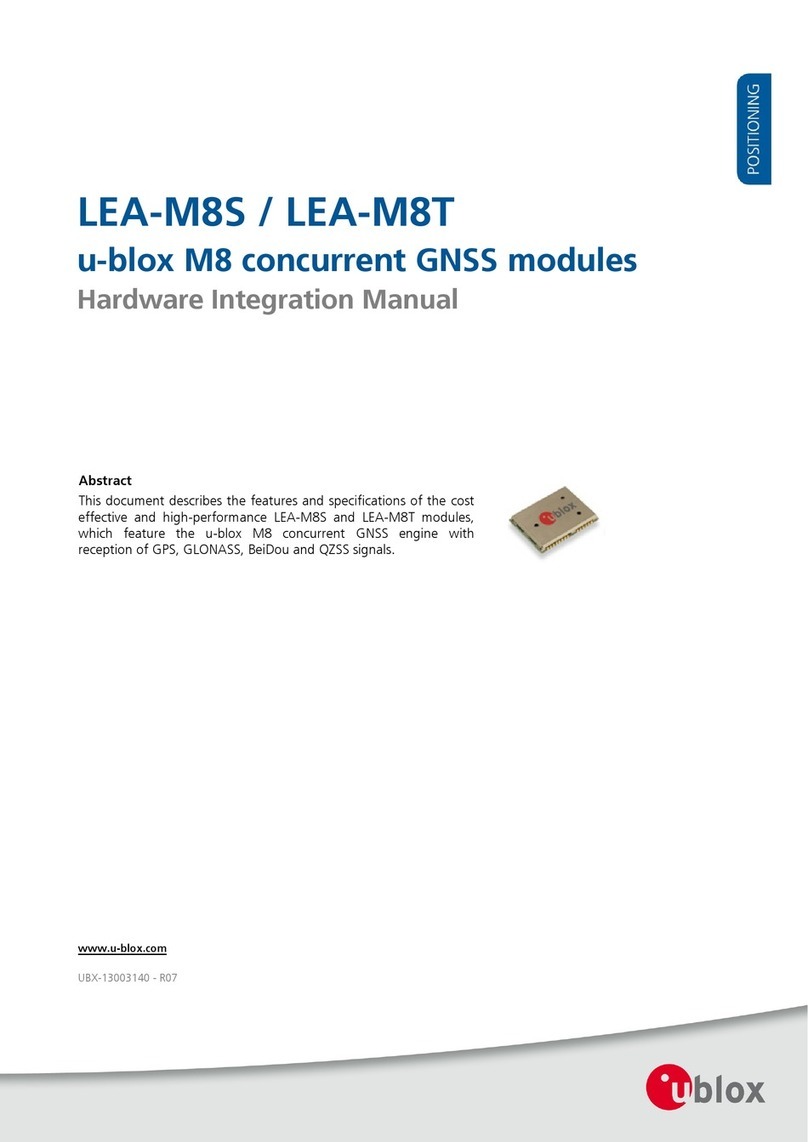
Ublox
Ublox LEA-M8S Hardware Integration Manual
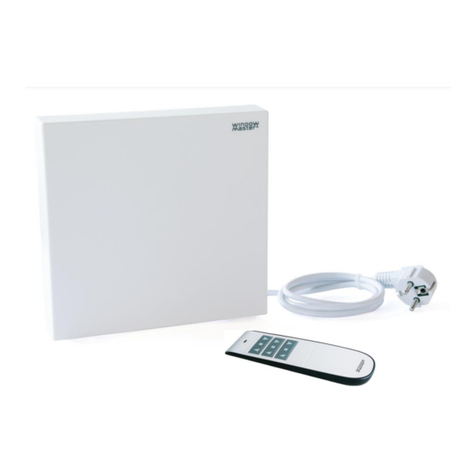
WindowMaster
WindowMaster WCC 106BT MotorController Installation instruction
